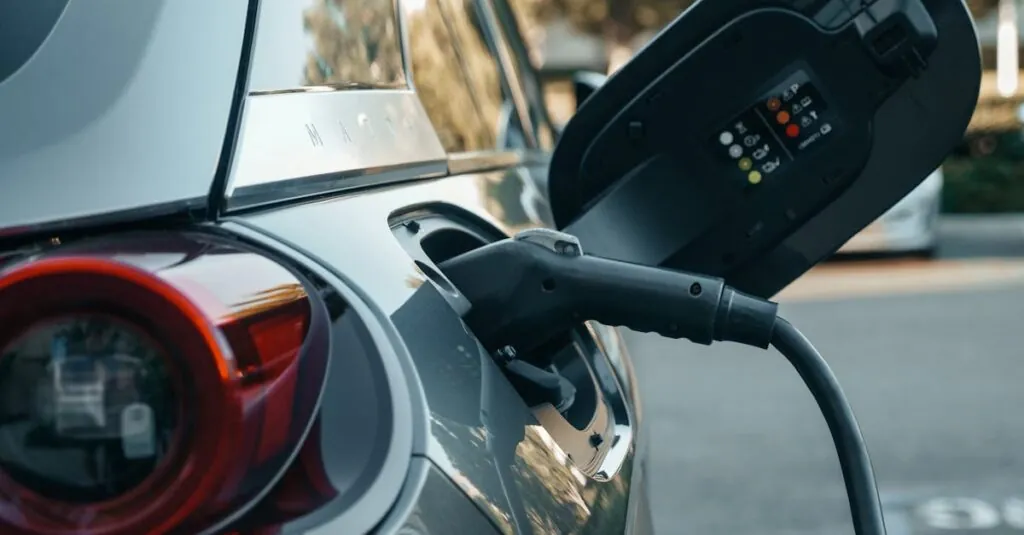As the world races towards a greener future, electric vehicles (EVs) are zooming into the spotlight. But who says going green has to be all about sacrifice? With enticing EV rebates, making the switch to an electric ride can feel less like a chore and more like a joyride. Imagine cruising down the street in your shiny new EV while your wallet thanks you for the generous rebates that come along for the ride.
These incentives are designed to make eco-friendly choices not just smart but downright irresistible. Whether you’re a seasoned EV enthusiast or just curious about the electric buzz, understanding how these rebates work can help you save big bucks. So buckle up and get ready to discover how EV rebates can electrify your wallet while you help save the planet.
Table of Contents
ToggleOverview of EV Rebates
EV rebates serve as financial incentives designed to encourage the adoption of electric vehicles. These rebates often reduce the overall purchase price, making EVs more accessible to consumers. Federal programs, along with state and local initiatives, provide varying amounts of rebates. For instance, the federal tax credit can reach up to $7,500 depending on the vehicle’s battery capacity and manufacturer.
State rebates vary significantly; some states offer incentives that range from $1,000 to $5,000. Factors such as income limits, vehicle eligibility, and used versus new EV purchases can affect these amounts. Many utility companies also provide additional rebates or incentives for homeowners who charge EVs during off-peak hours.
Eligibility requirements can differ among programs. Typically, consumers must purchase or lease an eligible vehicle and may need to apply through state or local government websites. Rebates often require specific documentation, such as proof of purchase and vehicle identification numbers.
EV rebates not only lighten the financial burden of purchasing an EV, but they also exemplify commitment to environmental sustainability. Improved local air quality and decreased reliance on fossil fuels represent key benefits of expanding EV use. As awareness of these financial incentives grows, more consumers are likely to consider the shift to electric vehicles.
Ultimately, understanding the details behind EV rebates empowers potential buyers to make informed decisions. The savings combined with ecological benefits can make owning an electric vehicle both financially smart and environmentally responsible.
Types of EV Rebates
Various types of EV rebates exist to encourage the adoption of electric vehicles. These incentives come from federal and state programs, influencing the transition to greener transportation.
Federal EV Rebates
Federal EV rebates provide significant financial assistance for consumers. Tax credits from the federal government can reach up to $7,500. Amounts vary based on the battery capacity of the vehicle and the manufacturer’s production numbers. As a consumer, it’s crucial to confirm eligibility requirements, which typically include purchasing or leasing an eligible vehicle. Documentation submission plays an important role in obtaining these credits, ensuring the process remains streamlined for qualified buyers.
State-Specific EV Rebates
State-specific EV rebates offer additional financial support, with amounts ranging from $1,000 to $5,000. Variations depend on state policies and consumer factors such as income limits and vehicle eligibility. Each state implements specific programs aimed at promoting electric vehicle use, thus making local incentives a valuable resource. Consumers need to check their respective state regulations to understand the unique offerings available. Additionally, some programs include benefits for low-income households, further expanding access to EV rebates.
Eligibility Criteria for EV Rebates
Eligibility criteria for EV rebates vary by program but typically include vehicle requirements and income limitations.
Vehicle Requirements
Eligible vehicles must usually meet specific criteria to qualify for rebates. All-electric vehicles and plug-in hybrids often receive the most financial incentives. Battery size, typically measured in kilowatt-hours, influences federal tax credit amounts. The total vehicle price may also determine eligibility, with some programs applying caps. Manufacturers with high sales may face phased-out rebates. Vehicle must be purchased or leased by the applicant, as rentals generally don’t qualify. Additionally, consumers should check local regulations, as state-specific rebates may impose extra conditions, ensuring they meet all necessary requirements before proceeding.
Income Limitations
Income limitations play a significant role in determining rebate eligibility. Many state programs intend to assist low- and moderate-income households, often defining specific income thresholds. Applicants typically must provide documentation of their income to confirm their eligibility. Federal tax credits generally lack income caps, allowing all buyers to benefit without restrictions. However, certain state programs may prioritize households below specific income levels. These income guidelines ensure that incentives support consumers who may face economic barriers to purchasing EVs. Checking local program stipulations can provide additional clarity and direction regarding potential income limitations.
Benefits of EV Rebates
EV rebates present notable advantages for consumers and the environment. These rebates lower the financial barrier to owning an electric vehicle, making it a practical choice for many.
Financial Incentives
Financial incentives significantly enhance the affordability of EVs. Federal programs offer rebates up to $7,500, which depend on battery capacity and manufacturer. Many state programs provide additional rebates ranging from $1,000 to $5,000, based on local policies and consumer circumstances. Utility companies often contribute by offering incentives for off-peak charging, further reducing costs. Altogether, these savings facilitate a smoother transition to electric vehicles. Consumers, especially low- and moderate-income households, can particularly benefit from state-specific programs tailored for their needs. With these financial supports, buying an EV becomes more accessible and appealing.
Environmental Impact
Environmental impact stands as another critical benefit of EV rebates. Transitioning to electric vehicles contributes to reduced greenhouse gas emissions, supporting climate goals and tackling global warming. Each EV on the road helps decrease reliance on fossil fuels, fostering cleaner air quality. Rebates not only promote eco-friendly choices but also encourage consumers to invest in sustainable technology. Enhanced air quality leads to improved public health, benefiting communities at large. The cumulative effect of increased EV adoption positively influences the environment, making it a necessary step towards a greener future.
Challenges and Considerations
Evaluating EV rebates involves understanding various challenges and factors that can affect their effectiveness and accessibility.
Availability and Variability
Availability of EV rebates varies significantly between federal, state, and local levels. Federal tax credits often apply uniformly, while state programs exhibit more variability based on local policies and funding. States may offer rebates that differ in amount, eligibility, and application processes. For instance, some states provide up to $5,000 depending on specific conditions like income and vehicle type. Local governments and utility companies might introduce additional incentives, further complicating the overall landscape. Prospective buyers should compare available rebates in their area to maximize savings effectively.
Changes in Legislation
Changes in legislation can impact the structure and amount of available EV rebates. Legislative sessions often revisit EV incentives, resulting in adjustments to eligibility criteria or rebate amounts. For example, some states might phase out rebates after a specific number of EVs are sold, while others may tighten income eligibility to target specific demographics. Federal initiatives may also evolve based on changing political climates or budgetary constraints. Staying informed about potential changes helps consumers anticipate future rebate availability and adjusts their purchasing strategies accordingly.
As the push for a sustainable future intensifies the importance of EV rebates can’t be overstated. These financial incentives not only make electric vehicles more accessible but also promote environmentally friendly choices. By understanding the various rebates available and their eligibility criteria consumers can navigate the landscape more effectively.
The shift towards electric vehicles is more than just a trend; it’s a vital step in reducing carbon footprints and enhancing air quality. With the right information and awareness about EV rebates potential buyers can make informed decisions that benefit both their wallets and the planet. Embracing electric vehicles is a forward-thinking choice that aligns with a greener tomorrow.





